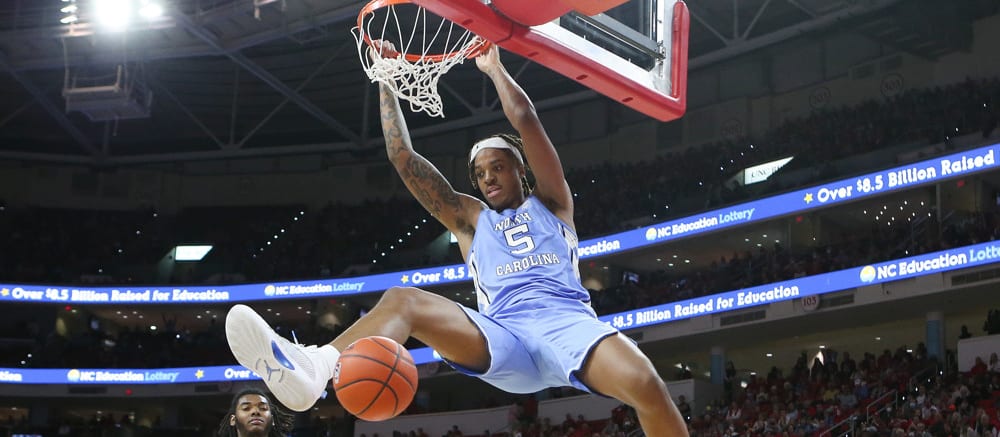March is here and Selection Sunday is days away. Are you ready?
For a live, updated bracket throughout the week check out our RotoWire Bracketology page.
This is my eighth year doing Bracketology, but the state of Bracketology is slightly different than when I started. Eight years ago, I started my own because I disagreed with Joe Lunardi and mostly everyone else in the media. Since then, the art of projecting seeds has only grown, as you can see at Bracket Matrix. If you didn't follow the Matrix, you wouldn't know that Jerry Palm (CBS) is one of the worst bracketologists on a yearly basis. But who cares, really? He's a talking head and he can project whatever seeds he wants to. If he's incorrect, he's not going to lose his job.
Maybe that's a pessimistic outlook, but there isn't as much fun in Bracketology anymore. That's because the NCAA's 10-person committee openly uses the Bracket Matrix, which they've confirmed in recent years. Last season, the Bracket Matrix average (which is the average from the hundreds of brackets it receives) tied for the third-best bracket of 200-plus entries. Prior to that, in 2019, it was in the top 20.
Sure, it's fun to guess what the committee is going to do, but not when the committee mostly follows the public and then maybe does a random thing or two so it can be different (see Louisville in 2021).
That's partly why I've focused a little more on the metrics this season and how teams are being rated. The bubble is always a talking point and Jesse Siegel covered that for RotoWire earlier in the week. I wrote about the 1-seeds at the end of January and nothing has changed, at least for me. In fact, I haven't changed my 1-seeds since that initial bracket: Gonzaga, Auburn, Baylor and Arizona.
The point of the Matrix is that it doesn't focus on one certain metric because the bracketologists use a variety of sources. Some are crazy and made to stand out, while others simply copy the Matrix or some of the top bracketologists. And that's what the committee more or less uses.
So, let's look at the Matrix.
I was going to compare the five ACC teams near the bubble, but it's an endless conversation of metrics and Quadrant records. North Carolina is finally off the bubble and all it needed was a win at Duke in the biggest game of the season in which everyone saw. The Tar Heels could've won at Notre Dame and barely anyone would've noticed, yet they would have ranked the same on their team sheet. Instead, they're now a consensus No. 9 seed at the Matrix, which is a two-seed bump from the past two months.
I think it's useful to look at certain teams and where they are being projected using metrics the committee uses. Of note, the NET continues to be tweaked, and it appears to be as close as ever to KenPom. Last season, it was only two weeks before Selection Sunday that the NET updated some numbers and suddenly teams with a strength of schedule outside the top 100 moved to the top 10. I'll continue to use NET because it's the NCAA's tool, but I'm not sure what its purpose is outside of being a fallback for the committee.
Should we blindly follow the metrics? That's kind of what the majority of bracketologists do, and in turn, that's what the committee will do. Why is there such a discrepancy in the teams above? The only answer is metrics.
 North Carolina: NET 32, 23-8 overall, 2-7 Q1, 3-0 Q2, one Q4 loss, BracketMatrix projected 9-seed,
North Carolina: NET 32, 23-8 overall, 2-7 Q1, 3-0 Q2, one Q4 loss, BracketMatrix projected 9-seed,
 Iowa: NET 15 22-9 overall, 2-6 Q1, 6-3 Q2, BracketMatrix projected 6-seed
Iowa: NET 15 22-9 overall, 2-6 Q1, 6-3 Q2, BracketMatrix projected 6-seed
What makes it more confusing is that Team A, North Carolina, has a Strength of Record (SOR) that ranks 18h in the country compared with Team B, Iowa, at 26. Yes, Iowa plays in a better conference, but what does it mean when it loses the majority of its games against elite competition? The Tar Heels have a Quad 4 loss, but that doesn't explain why they've been on the bubble the last two months.
The general consensus is that predictive metrics like KenPom and the NET are used to seed the top eight or so seed lines in the tournament, while performance metrics like SOR, decide who makes the tournament. However, that doesn't appear to be the case this season, at least ahead of Selection Sunday.
Earlier this week, Jerry Palm appeared on the Eye on College Basketball podcast and said Strength of Record isn't really used to seed teams. If a team's overall performance seen in Strength of Record isn't used, then what's the point?
While I personally like using a combination of KenPom and SOR for my bracket, that's not how the committee will look at things. Sure, there are some outliers in the metrics, mostly teams from smaller conferences, but for every poor metric team like Providence and Wisconsin, there is a Texas and Iowa.
So when you're watching on Selection Sunday and a team like Rutgers, which has wins against seven projected tournament teams (in comparison, Houston's best win is SMU) doesn't make the tournament, remember it's out of their hands. The Scarlet Knights are being punished for a couple losses back in November, which is why their metrics continue to struggle. I know the loss against Lafayette happened, but so did all of their wins, which happened to be more recent.
Metrics prior to games on Thursday, March 10.
For a live, updated bracket throughout the week check out our RotoWire Bracketology page.












































